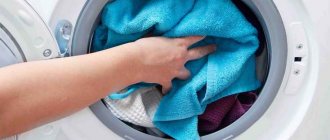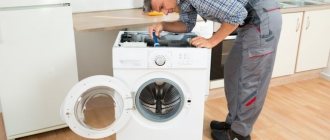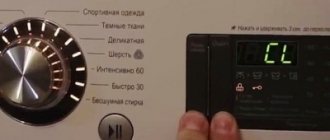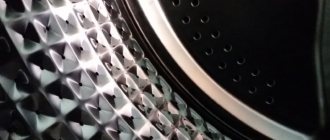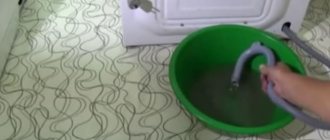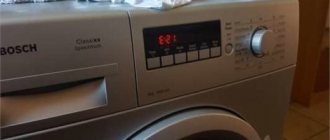The washing machine is making a loud noise
The occurrence of strong noise during operation of the washing machine rightfully worries its owner - after all, if the mechanisms are subject to excessive vibration, or knocking, grinding, humming, or squeaking is heard, then further operation of the equipment can lead to its failure.
To eliminate unpleasant noise, you need to determine in what mode the washing machine makes the loudest noise and find out why this happens. The nature of the sound is very important - even without disassembling the machine, by listening to its operation, you can determine the cause of the noise.
Why is the new washing machine trying to take off?
Very often, an unnatural hum and vibration can be heard even when you first start a new, just purchased washing machine, which literally jumps in place and even moves to the side, especially at high drum speeds. The reason for this phenomenon is the fastening transport bolts , which the owners forgot to unscrew, as required by the instructions.
Transport fastening bolts and a wrench for removing them
The purpose of these bolts is to rigidly fasten the suspended drum to the body of the washing machine so that during transportation it does not swing or hit the surfaces of internal structures. In operating condition, the center of gravity of the items loaded for washing will constantly and chaotically shift inside the drum.
To compensate for the displacement of the gravity of the rotating drum, its body (tank) is made movable, suspended on springs, and weighted with the help of heavy counterweights. Thus, in the washing machine, the tank with the drum is allowed to perform circular oscillatory movements, and the amplitude of the oscillations is directly proportional to the imbalance.
The tub with the drum is suspended on springs inside the washing machine
Tightened mounting bolts will transmit these vibrations to the body of the washing machine, and this will cause it to bounce. But sometimes this phenomenon also happens when the instructions regarding the mounting bolts are followed. In this case, there is a large imbalance of gravity - perhaps too much laundry is loaded, or it is bunched up in one part of the drum.
The red outline outlines the upper edges of the counterweight
If such a vibration, interspersed with dull knocks, is felt during a small load, then the counterweights may have become loose and they are wobbling up and down on loose bolts. This problem should be corrected immediately so that the counterweights are not damaged, which, as a rule, are made of special concrete, although strong, but not designed to withstand frequent impacts. A broken piece of the counterweight will cause a greater amplitude of vibration in the tank, which will increase the vibration.
Cracked counterweight due to loose fastening
Why does a working car hum and vibrate?
It is very important to ensure that the washing machine is level with the ground before starting it for the first time. If the body stands crooked, the tank on the suspension will move to the side, and there will be a risk of hitting the internal surfaces when the drum rotates quickly.
In the wrong position, the washing machine will constantly move to the side during operation. On a flat and smooth floor, there is a risk that a running washing machine, without encountering any obstacles, will tear out the drain hose from the sewer pipe and flood the entire room with water.
Checking the position of the washing machine using a building level
The position is adjusted using adjustable stands at the corners of the washing machine body, and checking is carried out with a building level. In addition to the absence of tilting, even distribution of weight on all four supports is also very important for quiet operation of the washing machine.
Adjustable washing machine stand
Even a small gap between the rack and the floor will contribute to the occurrence of resonant vibrations of the washing machine body. Often such fluctuations occur during spinning, at maximum drum speed. Having entered into resonance, the body of the washing machine will wobble greatly, while emitting a powerful hum in various ranges due to the deformation of the metal casing.
Clogged internal elements of the washing machine
If the washing machine hums loudly and evenly when draining, but does not pump out water for a long time, it means that of the pump is clogged There may be dirt, fur, hair and even hard objects - buttons and coins. The sump pump filter should be cleaned regularly as a preventative measure.
Severely clogged sump pump
To do this, open the decorative cover at the bottom of the washing machine. There should be a pipe with a plug to drain water from the pump. Substituting a small container in the form of a plate, drain the water and then, with some force, unscrew the filter, remove it and clean it.
External washing machine filter elements
It is necessary to separately describe an almost textbook case encountered by many washing machine repairmen - this is when an arcuate steel wire, a structural part of some bras, gets into the pump. Owners of such linen should wash small items in special bags, or even refuse to machine wash these items.
Supporting knitting needles (wires) of bras can cause damage to the washing machine
Foreign objects inside the drum
Random, chaotic tapping is heard, with a metallic sound. It appears in all operating modes of the washing machine, becoming more frequent during spinning (highest drum speeds). Possible causes are a foreign object getting into the drum. These could be coins, buttons, keychains, etc.
You need to switch the washing machine to drain, remove the water, open the door and remove these items from the drum before they get through the seal into the internal, inaccessible space of the tank body - in this case it will be much more difficult to get them out of there. A mandatory requirement of the instructions is to remove small items from your pockets.
Coins that got into the pump caused the pump impeller to break.
You need to be especially careful when washing workwear - there may be nails, screws, metal wires, etc. in its pockets. Due to their small diameter, they can penetrate into the interior through holes in the drum.
In addition to getting into the sump pump, sharp objects can damage the drum tank housing, heating element, and washing machine hoses.
The heating element is broken due to a steel knitting needle from a bra that went through one of the holes in the drum
Removing foreign objects from hard-to-reach places
If there are no foreign objects in the drum (let’s say towels are being washed in a washing machine - buttons are excluded), and chaotic metallic sounds appear from time to time, then small objects have already entered the space between the drum and the tank body. Sometimes sounds may disappear - this means that objects are stuck somewhere in the cavities of the case.
You should not calm down in this case - due to the vibration and flow of water, these objects can be drawn back into the whirlpool. If the circumstances are unfortunate, a metal object caught between the tank body and the drum can damage both surfaces at high speeds. In this case, the tank housing may leak, thereby damaging the washing machine motor.
Crack in the washing machine tank housing
To prevent this from happening, you should unscrew the back cover of the washing machine and open access to the installation site of the heating element. Having removed the heating element from the socket, you can remove the interfering objects using tweezers or a long hook. The entire process of dismantling and reinstalling the heating element is described in the previous article.
Often, after removing the heating element, users really don’t like what they see inside - large accumulations of dirt and scale, so they decide to completely disassemble the tank body and dismantle the drum in order to clean previously inaccessible surfaces.
The counterweight is loose
Such a breakdown is quite common in any model, which leads to a knocking sound in the Indesit washing machine during spinning.
The counterweight (load stone) is designed to weigh down and balance the unit tank. Therefore, if the fastening of the load weakens, then it begins to perform a completely opposite function, further weakening the tank of the car. It is for this reason that there is a knocking sound in the washing machine during the spin cycle.
Typically, the machine is equipped with two counterweights, one at the top and the other at the bottom of the tank. They are fastened using bolts, which are unscrewed during operation. You can fix the problem by tightening the loose screws.
If you notice that the counterweight has cracked, it is urgently necessary to replace it with a new device.
Why does the washing machine hum or whistle when washing?
Even in good condition, an automatic washing machine makes some noise and whistling, especially during intensive use, and this is completely normal. But there are times when the washing machine hums and rattles so much that it becomes annoying. In this situation, there may be a serious malfunction. In any case, this is a reason to think seriously and start looking for the cause of the unpleasant sound. We will talk about the causes of these sounds made by a washing machine, as well as ways to eliminate them, in this article.
Main causes of malfunction
Why does the washing machine spark, crackle, rattle and make a bunch of other different sounds that it is not supposed to produce? There can be quite a few reasons, and it is not always necessary to first of all pay attention to the moving elements of the washing machine, but first things first. Specialists with extensive experience in repairing automatic washing machines identify several of the most likely and common causes of the hum and whistle emitted by the “home assistant”; let’s look at them.
- Defective cuff of the washing machine hatch.
- The sound is caused by a foreign object getting into the washing machine and touching its moving elements during operation.
- The sound is caused by a defect in the moving elements of the washing machine (pulley, bearings, belt).
- The sound is caused by loosely dangling counterweights.
Note! When troubleshooting, move from simple to complex. There is no need to immediately rush to disassemble the tank and repair the bearings; first check the elements that are easier to reach; perhaps they are the cause of the unpleasant sound.
Hatch cuff defect
This reason may seem strange to some, like how could the cuff be due to the fact that the washing machine whistles and makes a grinding noise? In fact, the connection is direct! The cuff is a large rubber seal that is located around the hatch of the washing machine. Its task is to ensure that water from the tank does not spill out of the machine through the hatch. Under normal conditions, there is a small gap between the cuff and the edges of the rotating drum of the washing machine, and they do not touch each other, but it also happens differently.
In cheap models of washing machines, the cuff may be installed haphazardly or not fit well at all. The edges of the cuff fit right into the drum, catching its edges, or worse, the cuff doesn’t really fit into the groove, which makes it difficult to close the hatch. In this case, if the machine is new, it is better to send it to a service center for repair under warranty. If this is not possible, then you can try to correct the situation yourself.
If the edges of the cuff catch the edges of the drum, then you can proceed as follows.
- Open the hatch cover and inspect the cuff more closely.
- Rotate the drum by hand to the right and left and see which part of the cuff catches the edge of the drum.
- If the clinging edge is small, insert fine sandpaper into the gap between the desired edge of the cuff and run the machine in spin mode. The rapidly rotating drum will erase the protruding part of the gum, and the cause will be eliminated.
- If the clinging edge of the cuff is more than 0.5 cm thick, then removing it is dangerous; it is better to replace the cuff with a new, more suitable one.
Precautionary measures
In order for the machine to work for a long time, you must adhere to certain rules.
- You need to be vigilant and carefully inspect things for small parts that may come off during washing and get into the tank. It is better to put such things in a special laundry bag.
- Remove money and other small items from your pockets that could damage the machine during the washing process.
- Protect the heating element from scale that forms from hard running water. To do this, you need to use water softening and descaling products.
- It is necessary to move the washing machine at least once every six months and check the serviceability of the hoses, as well as flexible wiring and pipes for damage.
- Wash and clean the drawer for powder and rinse aid. If this is not done, hardened powder particles may accumulate in the machine, which will interfere with the normal operation of the equipment.
- After each wash, leave the powder container and the machine door open. This is necessary so that the internal parts of the washer dry thoroughly.
We invite you to familiarize yourself with the operating principle of the drying machine: types, design, drying modes
All these recommendations will help extend the life of the washing machine and protect it from frequent breakdowns and calls to service centers.
Some types of repairs can be carried out independently, but still, if the breakdown is serious, it is best to contact a service center and call a specialist to your home.
Why does the washing machine whistle when washing - Construction, repair, arrangement
Even in good condition, an automatic washing machine makes some noise and whistling, especially during intensive use, and this is completely normal. But there are times when the washing machine hums and rattles so much that it becomes annoying.
In this situation, there may be a serious malfunction. In any case, this is a reason to think seriously and start looking for the cause of the unpleasant sound.
We will talk about the causes of these sounds made by a washing machine, as well as ways to eliminate them, in this article.
Why is the washing machine so noisy?
Modern washing machines are distinguished not only by excellent quality of washing things, but also by such a pleasant “bonus” as low noise level during operation.
And this is really very important: you can start doing laundry at any time, even at night. Unfortunately, in some cases, washing machines begin to make noise. Sometimes due to breakdowns, sometimes due to not entirely correct operation.
Most often, owners contact the service center with complaints about the following noises:
- The washing machine makes a lot of noise when spinning, vibrates or even “jumps,” thereby creating additional noise.
- When draining water from the machine, the drain pump makes loud noises.
- The machine makes noise whenever the drum rotates: during washing, rinsing, spinning, and even if you simply turn the drum by hand.
- A loud noise is heard when drawing water.
Does this always indicate a breakdown? Let's figure it out.
Equipment may make sounds - this is normal.
It is worth understanding that a washing machine, like any unit, still creates some sounds during operation. In particular, you may hear:
- the sound of water pouring as it is drawn;
- the noise of a running drain pump (pump) when draining water;
- the sound of the engine when the drum rotates;
- drum noise at high speeds during spinning;
- clicks if the machine switches modes, for example, moves from the washing phase to rinsing mode, etc.;
- the noise of water heating, like in a kettle, during the washing process.
Source: https://gildiyamebel.com/pochemu-svistit-stiralnaya-mashina-pri-stirke/
DIY machine repair
To repair a machine yourself, you need to know its structure and operating principle. As a rule, repairs involve replacing old parts with new ones. When troubleshooting, you must first disconnect the machine from the power supply.
To replace parts yourself, you need to have a standard set of tools, and to repair the control board or electronics, you may also need a soldering iron.
Cleaning the drain filter
The first thing a washing machine owner can do is clean the filter. It often happens that small items of clothing or threads get there, which subsequently prevent the water from draining from the washing machine. To do this, you need to open the small cover located at the bottom of the machine and unscrew the small plastic plug using pliers.
After this, you need to clean the filter and rinse it under running water.
Cleaning the fill filter
This filter is located in the water intake hole. It can become clogged with small particles of dust or sand. To do this, you need to unscrew the inlet hose and use pliers to pull out the filter - a small plastic mesh that needs to be rinsed under water.
Replacing the heating element
If the repair involves replacing the heating element, you must first remove the back cover of the machine. Then disconnect the terminals and use a multimeter to check the element for functionality. The faulty heating element must be unscrewed using a wrench. After the old heating element is removed, you need to replace it with a new one. Be sure to install all parts in the correct order.
These are the most common types of repairs that you can easily carry out yourself. For more serious damage, it is better to contact a specialist.
Why does the washing machine hum and whistle when washing?
The washing machine is not silent during operation, but makes sounds - during washing, during rinsing or during the spin program.
But sometimes the car starts to rattle, hum, whistle and make noise very loudly, which does not have a positive effect on the human nervous system.
How to determine which noise is normal and which is not?
It all depends on the drive.
Why does the washing machine hum or whistle when washing?
In the belt drive version of the machine, it is normally considered to be from 60 to 72 dB, and if it is a direct drive, then from 52-70 dB. Otherwise, the sounds may indicate a malfunction of the machine.
Such a nuisance can occur when starting the machine for the first time. In this case, you can check the transportation bolts; maybe they were simply forgotten and not removed. Or perhaps the equipment is installed incorrectly and needs adjustment.
In other cases, there can be many reasons for failure. Let's look at the main points at which a car can make strange sounds.
Pulley
A common situation for old automatic machines. If the washing machine begins to hum or makes sounds similar to clicks, then most likely the pulley has become loose.
Belt
To get to the belt and pulley in order to check their performance, you need to:
- Remove the back cover, under which there is a large wheel - this is the pulley.
- Inspect the pulley for defects. If they are missing, move on.
- The drive belt is mounted on a pulley and requires careful examination for defects, because even a slight crack affects its operation.
Counterweight
If the belt is in working condition, then you need to get to the counterweight.
To do this, you must first find a counterweight. It looks like a big rock bolted to a car. If the mounting holes are larger than the bolts screwed into them, the counterweight must be replaced. To be 100 percent sure of the replacement, try rocking the counterweight from side to side. If it wobbles, it definitely needs to be replaced.
Bearing
An unsuccessful failure is a bearing failure. Why? Because it is very difficult to replace it yourself, but it is possible.
- You will need to remove the heating element and pull out the engine by moving the belt.
- Next comes the tank, which needs to be halved.
- All that remains is to knock out the bearings and replace them with new ones.
Typically, the seals that seal the tank are the first to wear out. In this case, moisture enters the bearing and it rusts and breaks.
Problem with the hatch cuff
The washing machine whistles or makes a loud noise during the spin cycle and it’s not clear what the cuff has to do with it?
But in fact, if the cuff is installed poorly, it may not fit into the groove of the machine, which prevents the hatch from closing tightly.
Or the cuff may hang down or even be installed “haphazardly”. If the cuff clings to the edge, the following steps will help fix it:
- Inspect the cuff.
- Find the clinging edge.
- To correct a small edge of up to 0.5 cm, you will need fine sandpaper (not a knife), which is inserted into the gap between this edge.
- The next step is to turn on the spin mode. The point is that the drum, rotating, will erase the protruding part, and the machine will stop making noise. If the edge is larger, then the best solution is to replace the cuff.
Foreign objects
The culprits of the malfunction are not always the moving elements of the machine.
The washing machine sometimes whistles when the drum rotates due to the presence of foreign objects.
These could be paper clips, pins, coins, nails, underwear bones, etc. These cute and small-sized items are quite capable of sending your car to the landfill.
If there is a foreign object between the drum and the cuff, it can be removed.
Broken spring and shock absorber
If any of these components fails, the machine drum may tilt to one side. And since the tank is warped, a characteristic knock occurs.
To determine which element is broken, you will have to disassemble the unit. If one spring breaks, it will be enough to replace only the faulty unit. But if one shock absorber breaks, then both devices must be replaced, since when replacing one failed shock absorber, the load will be distributed unevenly. This, as a result, will quickly lead to failure of the second element.
Why does the washing machine squeak?
Has your washing machine started squeaking? A sound that is heard as a squeak or something similar to a whistle may appear without any clear reason. That is, the machine worked and worked. All was good. And suddenly it creaked. That happens. There are also other reasons. For example, it may begin to make such sounds after the bearings have been changed. Or if the machine has worked for many years.
Such problems can occur both in all washing modes and in individual parts of the cycle. For example, during spinning, rinsing, main wash.
What could be causing the squeaking?
Let's look at all the reasons:
- Firstly, it may appear if the tank comes into contact with the side parts of the machine body. Such contact during washing can cause such sounds.
- Secondly, small items may get caught under the drum during the washing process. In this case, the creaking occurs from the friction of the item against the tank and drum of the machine.
- Thirdly, there are cases when wool, hairs and other particles of the washable material remain on the cuff of the hatch.
- Fourthly, there is a possibility that the drive belt has become loose. And the sound you hear may be caused by this belt slipping.
- Fifthly, the shaft fastening could weaken.
- Sixth, this sound can occur at the fixation points of the springs that hold the tank.
- And finally, seventhly, these unpleasant sounds can be created by the rubbing butt parts of the machine body.
Washing machine repair
Before starting any repairs, you must unplug the equipment from the outlet. So that we don't get electrocuted in the process. It is also necessary to stop the water supply by turning off the tap.
Retaining springs
Springs that fix the position of the tank can also cause a similar problem. Or rather, the creaking itself will create traction. They may rub against the mounting sockets during washing. How do you know if this is the main cause of the unpleasant sound? In order to check this option, you need to remove the upper part of the washing machine body. And during operation (just when it creaks), press on the seat. If the creaking disappears while pressing, then we have identified a malfunction. In order to remove it, it is necessary to lubricate the contact points between the spring rods and the mounting sockets.
You can use regular machine oil as a lubricant.
Stretched belt
When using the machine for a long time, the drive belt may stretch or wear out. With such a malfunction, the belt can spin, creating such an unpleasant sound in the process. In order to correct the situation, it is necessary to change the belt tension. That is, increase it. Or replace the worn belt with a new one. Below you can watch a video on replacing the belt:
Things got caught between the tank and the drum
As already mentioned above, small items can get caught under the drum of the washing machine when washing. Such things, being pressed between the tub and the drum, can make unpleasant sounds during washing. In order to remove foreign objects from this place, it is necessary to remove the heating element. He's TEN. And through the hole where this element was previously located, we take out and remove the thing.
Shaft
If the machine is used for a long time, the drum shaft may become loose. As a result, backlash occurs. And the shaft begins to creak when it comes into contact with the internal parts. In this case, we can easily fix the damage by tightening the fixing elements.
Contact of the washing machine tank with the walls
If during operation of your machine the tank comes into contact with the walls of the housing, this can also cause squeaking. In order to make sure that this is the problem, you need to check the fixation of the tank, springs and shock absorbers. If you notice any malfunction, fix it.
Cleaning the cuff
In some cases, small particles of laundry may fall onto the cuff of the washing machine door and remain there. Therefore, it is necessary to regularly check the cleanliness of the cuff and remove any such deposits. When cleaning, pay attention to the gaps. If the cuff is contaminated in this way, noise may occur from the contact of the debris and the rotating drum.
Frame
The washing machine body consists of several parts. They are usually connected using screws or other fastening elements. With prolonged use or poor-quality connections, friction may occur between individual parts of the housing. And friction, in turn, can cause squeaking. As you may have guessed, in order to solve this problem you just need to fix the parts of the body more tightly. That is, tighten the screws. In some cases, fasteners will also need to be replaced.
We hope that these instructions will help you with your repair!
Source: https://mashmaster.ru/pochemu-stiralnaya-mashina-skripit-chinim-sami/
Bearing and pulley wear
This malfunction can occur mainly during long-term operation of the washing machine. You can make sure that the bearings have fallen off by the characteristic creaking and intermittent rotation of the drum when you swing it by hand in different directions.
If the bearings are definitely damaged, then you will have to change them all at once, along with the seals. This is a complex job, so it is better to entrust it to a specialist from a service repair center.
Also, knocking can occur when a pulley fails or its fastening becomes loose. The problematic element must be tightened well and filled with sealant for reliability.
Remember that if extraneous noise is detected, you must immediately begin diagnosing the malfunction and eliminating the causes that caused it. Delay may result in more serious damage to your washing machine.
The most common causes of extraneous noise
There is nothing particularly complicated in the design of a washing machine. Therefore, there are not so many places where a malfunction can nest. It all depends on at what stage of washing the unusual noise and rattling occurs. The reasons why a loud noise is heard may be as follows:
- The bearing installed in the drum drive has become unusable.
- The mounting bolts holding the tank in place during transportation were not removed.
- The drive pulley is loose.
- The counterweights holding the drum are loose or crumbled.
- Some small objects got between the drum and the wall of the tank and got stuck there.
- The drain pump is broken.
- The rubber seal located on the hatch cover has crumbled or does not fit properly.
- The washing machine is not installed level.
See also -
Why does powder remain in the washing machine tray after washing?
Line filter malfunction
An equally popular malfunction is an unscrewed or broken-off surge protector, which is designed to dampen electrical network impulses. It is located on the back wall of the washing machine.
When the filter flies off the mount, it swings on the wires between the housing and the tank, which leads to a characteristic unpleasant knock. Also, such a breakdown can lead to a short circuit, and these are more complex problems in the operation of the unit.
To resolve this problem, the filter must be securely fastened.
Call the master
Replacing a drum costs at least 3,500 rubles, excluding expenses for the part itself. Work completion time is from 1 to 3 hours. The average warranty period is 1 year.
When calling a specialist, you need to contact trusted specialists . It is recommended to give preference to repairmen from a large company that has its own website and office in the city.
To minimize the risk of encountering scammers, you first need to study reviews about the company on the Internet. Contacts of masters can be found on the Internet or in newspaper advertisements.
Calibration
The Samsung washing machine independently determines the weight of the items loaded into it. To make this value more accurate, you need to run the calibration mode.
This is done in several steps:
- Switch off the device and empty it.
- Press the “Temperature” and “Delay End” buttons simultaneously, and then “Power”. The device should turn on.
- Click on the “Start” button, this will activate the calibration mode.
- The drum will begin to rotate clockwise and counterclockwise. The whole process takes about 3 minutes.
- When it stops, “End” will appear and the device will turn off.
After calibration, the equipment is completely ready for washing.
Depending on the model, the process may differ slightly, so before starting the machine you need to study the instructions.
The laundry inside the drum is unevenly distributed
This problem often affects early models. The clothes bunch up in a big ball and hit the body during the washing process. As a result, an imbalance appears. To correct the situation, you need to pause the washing program and lay out the laundry more evenly. It is worth mentioning that new models from Indesit, Ariston, Samsung, LG and others do not have such problems.
Faulty parts
The reason that the drum knocks when the washing machine picks up speed may be a malfunction of the springs and shock absorbers. These devices are needed to compensate for vibration and provide balance to the structure. Over time, they can wear out, leading to an unpleasant knocking noise. Plus, the springs stretch and become less elastic. Because of this, the tank moves and hits adjacent parts during washing. If you suddenly hear a knocking sound from the washing machine during the spin cycle, you must stop it immediately. Then disconnect from the network and carry out diagnostics. If the guesses are confirmed, the failed elements will need to be replaced.
